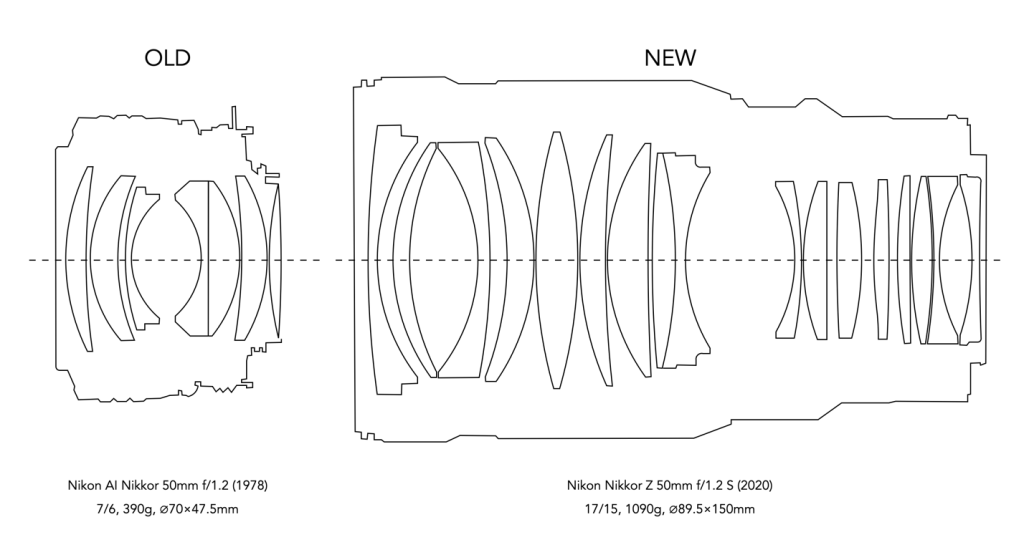Very few high-end camera companies have delved into the sub-f/1.2 genre of lenses, even for digital. The likes of Canon and Nikon have played that game before, in the 1960s, and are too practical to make that mistake again. The only ultrafast lens produced by a camera manufacturer is the Leica Noctilux-M 50mm f/0.95 Asph. Made for digital cameras, it has been in production since 2008. But at US$13K it is hardly a lens for the masses.
“The reason to buy a high-speed lens is to allow shooting in low-light situations or with short shutter speeds. Your photos may not be super-sharp, but at least you get a picture. If you need the high speed, then this f/1.4 lens or an f/1.2 version are the ones to have. However, if you can accept a speed of f/2, which is still plenty fast, then the slower lens is sharper. As an added benefit, the f/2 lens will be less costly than a faster one.”
G.H. Smith, Camera Lenses: From box camera to digital, SPIE (2006)
If you compare the inside of a modern digital lens versus its vintage analog compatriot, the first thing you might notice it the extreme complexity found in the modern lens. Consider the two lenses shown below. The Nikon AI Nikkor 50mm f/1.2 hailing from 1978 has 7 elements in 6 groups. Spring forward to 2020, and the Nikon Nikkor X 50mm f/1.2 S has a mind-blowing 17 elements in 15 groups. It’s also almost three times the weight of its predecessor. Is the image better? That is really in the eyes of the beholder.

Of the dedicated, high-end, lens companies only Voigtländer really stands out. They make lenses for a number of varied camera mounts. For Micro-Four Thirds (MFT) they actually offer a range of f/0.95 aspherical lenses, 10.5mm (21mm), 17.5mm (35mm), 25mm (50mm), 42.5mm (85mm), and 60mm (120mm). There is even a faster f/0.8 29mm (58mm) lens. These in reality are made for crop-sensors, with their full-frame equivalents more in the line of f/1.9. If one were to create a MFT equivalent of the Noctilux-M 50mm f/0.95, you would need something along the lines of a f/0.5. There are also third-party companies producing “inexpensive” ultrafast lenses (often by means of innovative lens designs). For example the Venus Optics Laowa, TTArtisan, Mitakon Zhongyi Speedmaster, Meike, 7artisans all have f/0.95 optics in various focal lengths, and sensors sizes. In 2022 TTArtisan introduced an f/0.95 35mm lens for APS-C for US$200.
But I do wonder why there is such interest in f/0.95 lenses? Dreamy bokeh? Why not just make f/1.0 lenses? I mean there isn’t that much difference between f/0.95 and f/1.0 – like 1/7th of a stop. I imagine it’s a marketing spiel, just like I imagine it was for Canon when they introduced their 50mm f/0.95 lens back in 1961. It’s a gimmick in the same way that items that cost $1.99 are perceived as cheaper than those marked $2. Why not go even further? I mean Voigtländer do have their f/0.8 29mm (58mm) super aspherical for MFT, which they toute as a world first (as of 2021), and introduce in their literature as the “conqueror of the night”. It’s not the fastest 35mm lens every made either, that honour goes to the Carl Zeiss Planar 50mm f/0.7.
There are limits to what lens speed will do for photography. An f/0.95 lens already has a very small depth of field, so small it makes it hard to focus. Many of these lenses may not even be that usable fully open, requiring them to be stopped down to f/2 before any semblance of usability is invoked. Sure, great for low-light but how often does anyone need that? Too many people use these lenses just for the bokeh effect, but that’s another story altogether. Somebody must be buying the Leica lens, as they are still making it. Likely more people are buying the cheaper lenses, just to experiment with. Check out this review of the TTArtisan 50mm f/0.95 by Dustin Abbott, who describes one of the pros as being “fun in low light”, and ultimately maybe that’s how we should view these ultrafast lenses, for fun, creative photography.
P.S. I do own a MFT f/0.95, more by happenstance than anything else. A few years back I bought the original Voigtländer 25mm f/0.95 (used, not new) for my Olympus MFT camera. It’s an incredibly solid lens, but it’s shallow DOF does make it tricky to focus.
Pingback: Should you buy a superfast lens? | Crafting Pixels